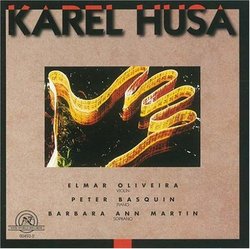| All Artists: Karel Husa, David Oei, Peter Basquin, Elizabeth Rodgers, Barbara Ann Martin Title: Husa: Violin Sonata; Piano Sonata No. 2; 12 Moravian Songs Members Wishing: 0 Total Copies: 0 Label: New World Records Release Date: 1/30/1996 Genres: Pop, Classical Styles: Vocal Pop, Chamber Music, Historical Periods, Classical (c.1770-1830), Instruments, Strings Number of Discs: 1 SwapaCD Credits: 1 UPC: 093228049326 |
Search - Karel Husa, David Oei, Peter Basquin :: Husa: Violin Sonata; Piano Sonata No. 2; 12 Moravian Songs
 | Karel Husa, David Oei, Peter Basquin Husa: Violin Sonata; Piano Sonata No. 2; 12 Moravian Songs Genres: Pop, Classical
|
Larger Image |
CD Details |
CD ReviewsNew, unusual and significant sonatas from the early to mid s Discophage | France | 01/30/2007 (4 out of 5 stars) "This collection stems from three Grenadilla LPs, two recorded in 1978 and one ten years later. Grenadilla GS-1032 contained Husa's 1972 violin and piano sonata, and back then violinist Elmar Oliveira was still the recent winner of the famous Tchaikovsky competition, and first American fiddler to do so. It was paired with Pamela Layman's aleatoric "Gravitation 1". The 1975 second piano sonata appeared a few months later on GS-1025 with works by Ingolf Dahl (Sonata da Camera for clarinet & piano) and David Diamond (Vocalises for soprano & viola). There was a nearly contemporary recording of the sonata, published on a Golden Crest LP with a more coherent coupling of Husa's 1943 sonatina, first piano sonata from 1949 and 1957 Elegy, all played by Mary Ann Covert, but it has not been reissued on CD. The Moravian songs were recorded and published in 1988 on GSC 1073, coupled with Alan Hovhaness' "O Lady Moon" for soprano, clarinet and piano and Walter Piston's violin and piano sonata from 1939. Astounding to think that as far as 1988 there were still labels who insisted on publishing only on LP.
In the sonatas, Husa's musical language is entirely contemporary. He uses a vast array of modern playing techniques, giving the pieces much color if not always very remarkable structural coherence: ostinati, repeated notes, plucked piano strings, clusters struck with depressed sustaining pedal, creating piano harmonics (Schoenberg was the first to use that effect), playing in the highest and lowest registers, sliding tones, quarter-tones and harmonics on the violin. The piano writing is oftentimes reminiscent of Crumb, whose unique compositional personality comes precisely from the coloristic effects borne from the use of such techniques. The violin effects sometimes evoke the masterful "Caprices" of Salvatore Sciarrino - actually written a few years later. Architecturally, both pieces pay some tribute to sonata form by broadly following a fast-slow-fast construction and contrasting moods within each movement. The playing seems fully authoritative, the sound is entirely up-to-date. Husa is quoted by the liner notes saying "it is difficult to add something new, unusual and, hopefully, significant... Yet, newer ways always arise." Well, in the case of the two compositions, they have. The 12 Moravian Songs come from an earlier period of Husa's compositional life and inhabit an entirely different stylistic universe. They were written in 1955 after authentic Moravian folk songs remembered by Husa, who hardly changed the melodic line but added a discreet piano part of his own. Pleasant though hardly memorable, they are here finely sung by Barbara Ann Martin in stylish English translations by Ruth Martin. As customary with New World Records, excellent notes, with selective bibliography and discography. " |

 Track Listings (19) - Disc #1
Track Listings (19) - Disc #1